Training and Assessment Strategy Template
VerifiedAdded on 2022/12/18
|9
|3998
|1
AI Summary
This document provides a training and assessment strategy template for delivering the Certificate II in Kitchen Operations course. It includes information on the purpose of the program, target audience, budget, constraints, delivery mode, and required resources.
Contribute Materials
Your contribution can guide someone’s learning journey. Share your
documents today.
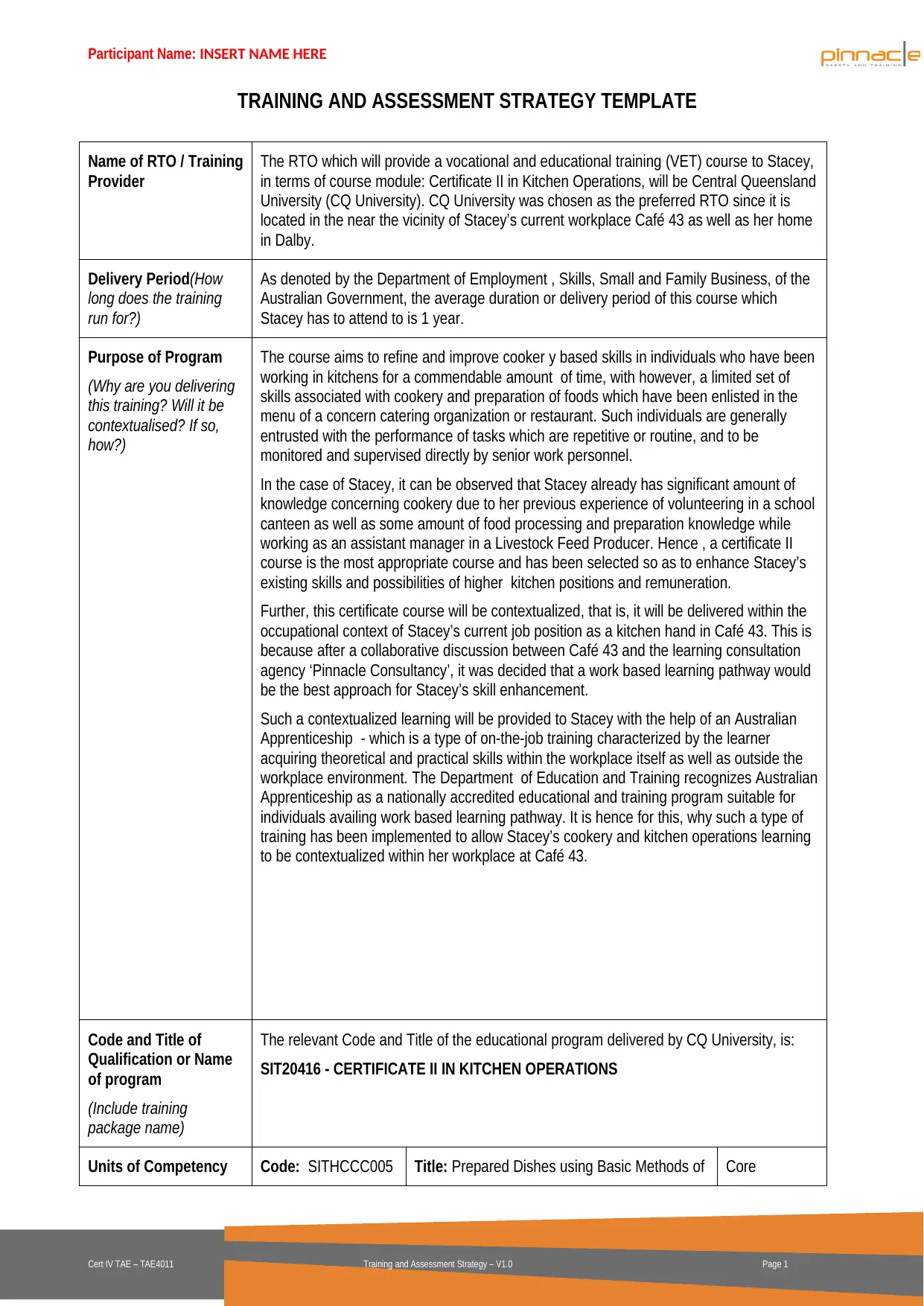
Participant Name: INSERT NAME HERE
TRAINING AND ASSESSMENT STRATEGY TEMPLATE
Name of RTO / Training
Provider
The RTO which will provide a vocational and educational training (VET) course to Stacey,
in terms of course module: Certificate II in Kitchen Operations, will be Central Queensland
University (CQ University). CQ University was chosen as the preferred RTO since it is
located in the near the vicinity of Stacey’s current workplace Café 43 as well as her home
in Dalby.
Delivery Period(How
long does the training
run for?)
As denoted by the Department of Employment , Skills, Small and Family Business, of the
Australian Government, the average duration or delivery period of this course which
Stacey has to attend to is 1 year.
Purpose of Program
(Why are you delivering
this training? Will it be
contextualised? If so,
how?)
The course aims to refine and improve cooker y based skills in individuals who have been
working in kitchens for a commendable amount of time, with however, a limited set of
skills associated with cookery and preparation of foods which have been enlisted in the
menu of a concern catering organization or restaurant. Such individuals are generally
entrusted with the performance of tasks which are repetitive or routine, and to be
monitored and supervised directly by senior work personnel.
In the case of Stacey, it can be observed that Stacey already has significant amount of
knowledge concerning cookery due to her previous experience of volunteering in a school
canteen as well as some amount of food processing and preparation knowledge while
working as an assistant manager in a Livestock Feed Producer. Hence , a certificate II
course is the most appropriate course and has been selected so as to enhance Stacey’s
existing skills and possibilities of higher kitchen positions and remuneration.
Further, this certificate course will be contextualized, that is, it will be delivered within the
occupational context of Stacey’s current job position as a kitchen hand in Café 43. This is
because after a collaborative discussion between Café 43 and the learning consultation
agency ‘Pinnacle Consultancy’, it was decided that a work based learning pathway would
be the best approach for Stacey’s skill enhancement.
Such a contextualized learning will be provided to Stacey with the help of an Australian
Apprenticeship - which is a type of on-the-job training characterized by the learner
acquiring theoretical and practical skills within the workplace itself as well as outside the
workplace environment. The Department of Education and Training recognizes Australian
Apprenticeship as a nationally accredited educational and training program suitable for
individuals availing work based learning pathway. It is hence for this, why such a type of
training has been implemented to allow Stacey’s cookery and kitchen operations learning
to be contextualized within her workplace at Café 43.
Code and Title of
Qualification or Name
of program
(Include training
package name)
The relevant Code and Title of the educational program delivered by CQ University, is:
SIT20416 - CERTIFICATE II IN KITCHEN OPERATIONS
Units of Competency Code: SITHCCC005 Title: Prepared Dishes using Basic Methods of Core
Cert IV TAE – TAE4011 Training and Assessment Strategy – V1.0 Page 1
TRAINING AND ASSESSMENT STRATEGY TEMPLATE
Name of RTO / Training
Provider
The RTO which will provide a vocational and educational training (VET) course to Stacey,
in terms of course module: Certificate II in Kitchen Operations, will be Central Queensland
University (CQ University). CQ University was chosen as the preferred RTO since it is
located in the near the vicinity of Stacey’s current workplace Café 43 as well as her home
in Dalby.
Delivery Period(How
long does the training
run for?)
As denoted by the Department of Employment , Skills, Small and Family Business, of the
Australian Government, the average duration or delivery period of this course which
Stacey has to attend to is 1 year.
Purpose of Program
(Why are you delivering
this training? Will it be
contextualised? If so,
how?)
The course aims to refine and improve cooker y based skills in individuals who have been
working in kitchens for a commendable amount of time, with however, a limited set of
skills associated with cookery and preparation of foods which have been enlisted in the
menu of a concern catering organization or restaurant. Such individuals are generally
entrusted with the performance of tasks which are repetitive or routine, and to be
monitored and supervised directly by senior work personnel.
In the case of Stacey, it can be observed that Stacey already has significant amount of
knowledge concerning cookery due to her previous experience of volunteering in a school
canteen as well as some amount of food processing and preparation knowledge while
working as an assistant manager in a Livestock Feed Producer. Hence , a certificate II
course is the most appropriate course and has been selected so as to enhance Stacey’s
existing skills and possibilities of higher kitchen positions and remuneration.
Further, this certificate course will be contextualized, that is, it will be delivered within the
occupational context of Stacey’s current job position as a kitchen hand in Café 43. This is
because after a collaborative discussion between Café 43 and the learning consultation
agency ‘Pinnacle Consultancy’, it was decided that a work based learning pathway would
be the best approach for Stacey’s skill enhancement.
Such a contextualized learning will be provided to Stacey with the help of an Australian
Apprenticeship - which is a type of on-the-job training characterized by the learner
acquiring theoretical and practical skills within the workplace itself as well as outside the
workplace environment. The Department of Education and Training recognizes Australian
Apprenticeship as a nationally accredited educational and training program suitable for
individuals availing work based learning pathway. It is hence for this, why such a type of
training has been implemented to allow Stacey’s cookery and kitchen operations learning
to be contextualized within her workplace at Café 43.
Code and Title of
Qualification or Name
of program
(Include training
package name)
The relevant Code and Title of the educational program delivered by CQ University, is:
SIT20416 - CERTIFICATE II IN KITCHEN OPERATIONS
Units of Competency Code: SITHCCC005 Title: Prepared Dishes using Basic Methods of Core
Cert IV TAE – TAE4011 Training and Assessment Strategy – V1.0 Page 1
Secure Best Marks with AI Grader
Need help grading? Try our AI Grader for instant feedback on your assignments.
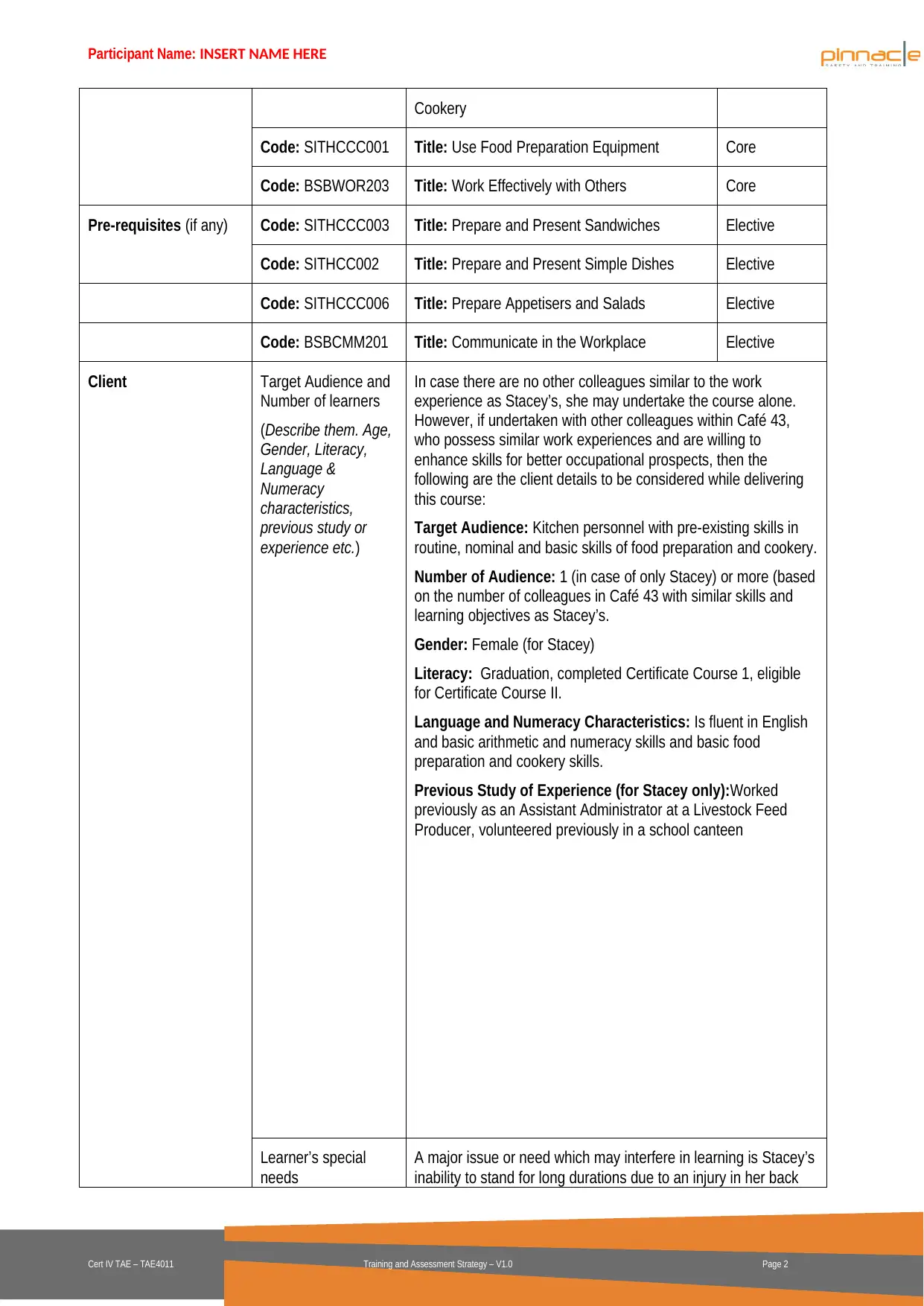
Participant Name: INSERT NAME HERE
Cookery
Code: SITHCCC001 Title: Use Food Preparation Equipment Core
Code: BSBWOR203 Title: Work Effectively with Others Core
Pre-requisites (if any) Code: SITHCCC003 Title: Prepare and Present Sandwiches Elective
Code: SITHCC002 Title: Prepare and Present Simple Dishes Elective
Code: SITHCCC006 Title: Prepare Appetisers and Salads Elective
Code: BSBCMM201 Title: Communicate in the Workplace Elective
Client Target Audience and
Number of learners
(Describe them. Age,
Gender, Literacy,
Language &
Numeracy
characteristics,
previous study or
experience etc.)
In case there are no other colleagues similar to the work
experience as Stacey’s, she may undertake the course alone.
However, if undertaken with other colleagues within Café 43,
who possess similar work experiences and are willing to
enhance skills for better occupational prospects, then the
following are the client details to be considered while delivering
this course:
Target Audience: Kitchen personnel with pre-existing skills in
routine, nominal and basic skills of food preparation and cookery.
Number of Audience: 1 (in case of only Stacey) or more (based
on the number of colleagues in Café 43 with similar skills and
learning objectives as Stacey’s.
Gender: Female (for Stacey)
Literacy: Graduation, completed Certificate Course 1, eligible
for Certificate Course II.
Language and Numeracy Characteristics: Is fluent in English
and basic arithmetic and numeracy skills and basic food
preparation and cookery skills.
Previous Study of Experience (for Stacey only):Worked
previously as an Assistant Administrator at a Livestock Feed
Producer, volunteered previously in a school canteen
Learner’s special
needs
A major issue or need which may interfere in learning is Stacey’s
inability to stand for long durations due to an injury in her back
Cert IV TAE – TAE4011 Training and Assessment Strategy – V1.0 Page 2
Cookery
Code: SITHCCC001 Title: Use Food Preparation Equipment Core
Code: BSBWOR203 Title: Work Effectively with Others Core
Pre-requisites (if any) Code: SITHCCC003 Title: Prepare and Present Sandwiches Elective
Code: SITHCC002 Title: Prepare and Present Simple Dishes Elective
Code: SITHCCC006 Title: Prepare Appetisers and Salads Elective
Code: BSBCMM201 Title: Communicate in the Workplace Elective
Client Target Audience and
Number of learners
(Describe them. Age,
Gender, Literacy,
Language &
Numeracy
characteristics,
previous study or
experience etc.)
In case there are no other colleagues similar to the work
experience as Stacey’s, she may undertake the course alone.
However, if undertaken with other colleagues within Café 43,
who possess similar work experiences and are willing to
enhance skills for better occupational prospects, then the
following are the client details to be considered while delivering
this course:
Target Audience: Kitchen personnel with pre-existing skills in
routine, nominal and basic skills of food preparation and cookery.
Number of Audience: 1 (in case of only Stacey) or more (based
on the number of colleagues in Café 43 with similar skills and
learning objectives as Stacey’s.
Gender: Female (for Stacey)
Literacy: Graduation, completed Certificate Course 1, eligible
for Certificate Course II.
Language and Numeracy Characteristics: Is fluent in English
and basic arithmetic and numeracy skills and basic food
preparation and cookery skills.
Previous Study of Experience (for Stacey only):Worked
previously as an Assistant Administrator at a Livestock Feed
Producer, volunteered previously in a school canteen
Learner’s special
needs
A major issue or need which may interfere in learning is Stacey’s
inability to stand for long durations due to an injury in her back
Cert IV TAE – TAE4011 Training and Assessment Strategy – V1.0 Page 2
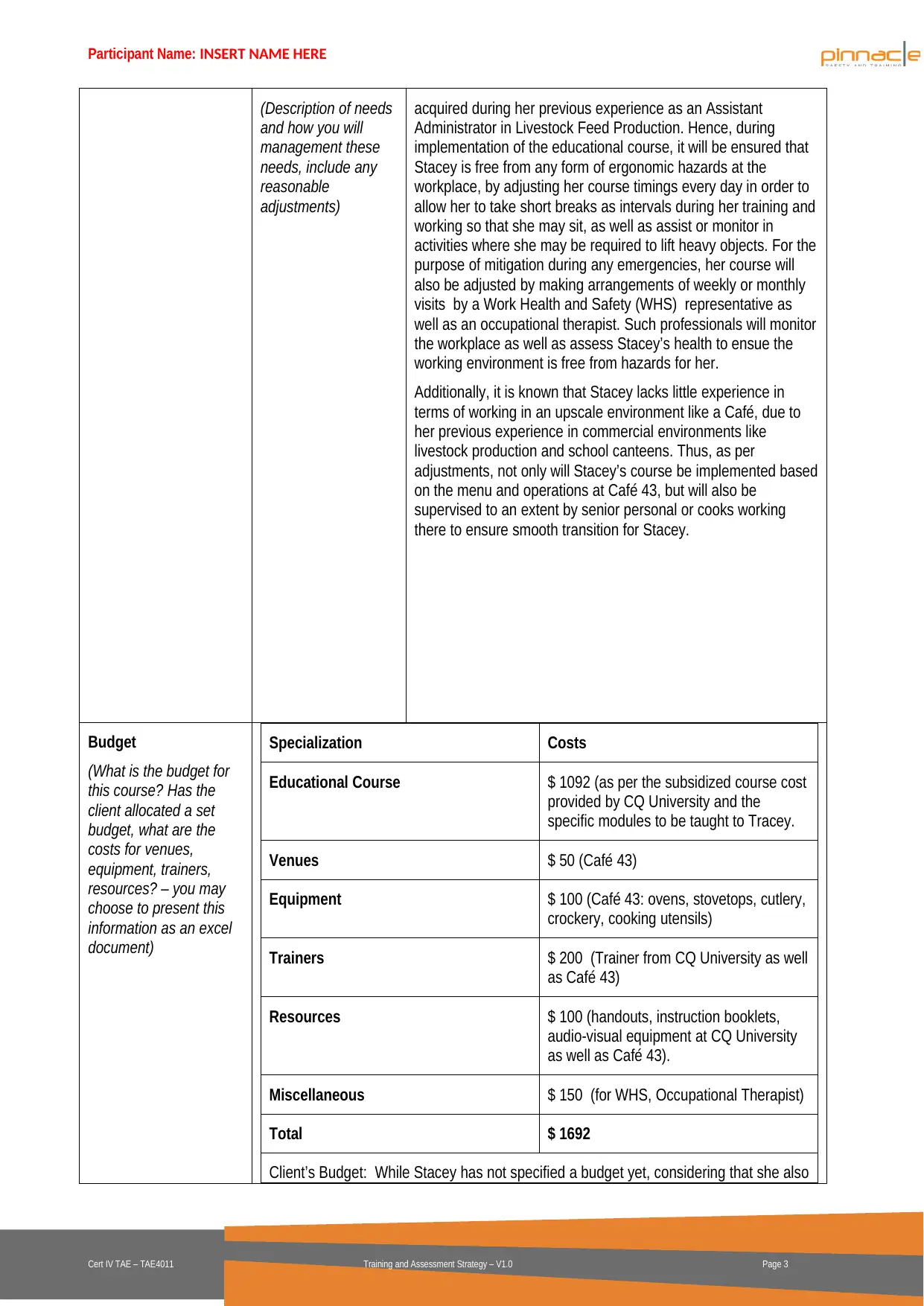
Participant Name: INSERT NAME HERE
(Description of needs
and how you will
management these
needs, include any
reasonable
adjustments)
acquired during her previous experience as an Assistant
Administrator in Livestock Feed Production. Hence, during
implementation of the educational course, it will be ensured that
Stacey is free from any form of ergonomic hazards at the
workplace, by adjusting her course timings every day in order to
allow her to take short breaks as intervals during her training and
working so that she may sit, as well as assist or monitor in
activities where she may be required to lift heavy objects. For the
purpose of mitigation during any emergencies, her course will
also be adjusted by making arrangements of weekly or monthly
visits by a Work Health and Safety (WHS) representative as
well as an occupational therapist. Such professionals will monitor
the workplace as well as assess Stacey’s health to ensue the
working environment is free from hazards for her.
Additionally, it is known that Stacey lacks little experience in
terms of working in an upscale environment like a Café, due to
her previous experience in commercial environments like
livestock production and school canteens. Thus, as per
adjustments, not only will Stacey’s course be implemented based
on the menu and operations at Café 43, but will also be
supervised to an extent by senior personal or cooks working
there to ensure smooth transition for Stacey.
Budget
(What is the budget for
this course? Has the
client allocated a set
budget, what are the
costs for venues,
equipment, trainers,
resources? – you may
choose to present this
information as an excel
document)
Specialization Costs
Educational Course $ 1092 (as per the subsidized course cost
provided by CQ University and the
specific modules to be taught to Tracey.
Venues $ 50 (Café 43)
Equipment $ 100 (Café 43: ovens, stovetops, cutlery,
crockery, cooking utensils)
Trainers $ 200 (Trainer from CQ University as well
as Café 43)
Resources $ 100 (handouts, instruction booklets,
audio-visual equipment at CQ University
as well as Café 43).
Miscellaneous $ 150 (for WHS, Occupational Therapist)
Total $ 1692
Client’s Budget: While Stacey has not specified a budget yet, considering that she also
Cert IV TAE – TAE4011 Training and Assessment Strategy – V1.0 Page 3
(Description of needs
and how you will
management these
needs, include any
reasonable
adjustments)
acquired during her previous experience as an Assistant
Administrator in Livestock Feed Production. Hence, during
implementation of the educational course, it will be ensured that
Stacey is free from any form of ergonomic hazards at the
workplace, by adjusting her course timings every day in order to
allow her to take short breaks as intervals during her training and
working so that she may sit, as well as assist or monitor in
activities where she may be required to lift heavy objects. For the
purpose of mitigation during any emergencies, her course will
also be adjusted by making arrangements of weekly or monthly
visits by a Work Health and Safety (WHS) representative as
well as an occupational therapist. Such professionals will monitor
the workplace as well as assess Stacey’s health to ensue the
working environment is free from hazards for her.
Additionally, it is known that Stacey lacks little experience in
terms of working in an upscale environment like a Café, due to
her previous experience in commercial environments like
livestock production and school canteens. Thus, as per
adjustments, not only will Stacey’s course be implemented based
on the menu and operations at Café 43, but will also be
supervised to an extent by senior personal or cooks working
there to ensure smooth transition for Stacey.
Budget
(What is the budget for
this course? Has the
client allocated a set
budget, what are the
costs for venues,
equipment, trainers,
resources? – you may
choose to present this
information as an excel
document)
Specialization Costs
Educational Course $ 1092 (as per the subsidized course cost
provided by CQ University and the
specific modules to be taught to Tracey.
Venues $ 50 (Café 43)
Equipment $ 100 (Café 43: ovens, stovetops, cutlery,
crockery, cooking utensils)
Trainers $ 200 (Trainer from CQ University as well
as Café 43)
Resources $ 100 (handouts, instruction booklets,
audio-visual equipment at CQ University
as well as Café 43).
Miscellaneous $ 150 (for WHS, Occupational Therapist)
Total $ 1692
Client’s Budget: While Stacey has not specified a budget yet, considering that she also
Cert IV TAE – TAE4011 Training and Assessment Strategy – V1.0 Page 3
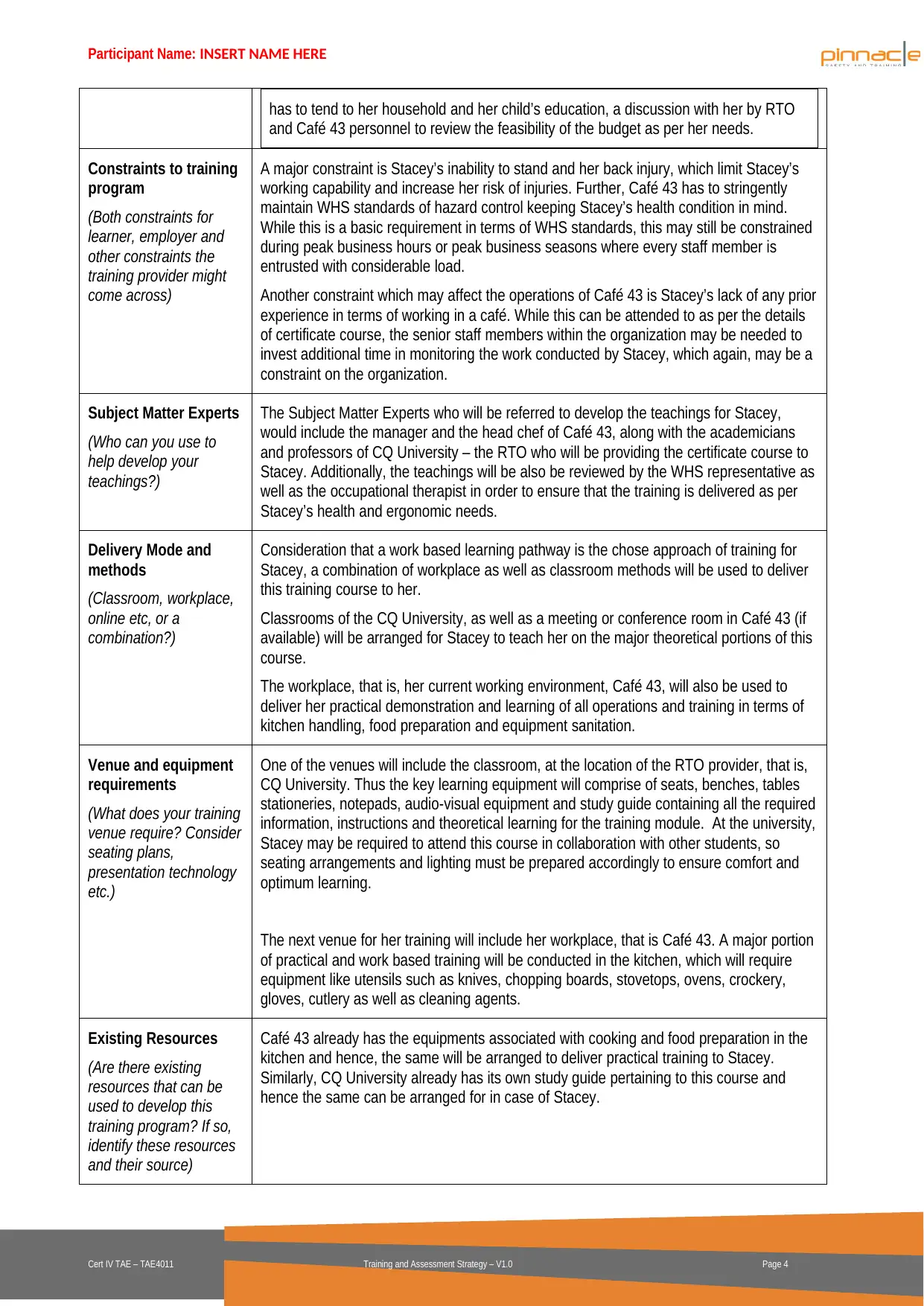
Participant Name: INSERT NAME HERE
has to tend to her household and her child’s education, a discussion with her by RTO
and Café 43 personnel to review the feasibility of the budget as per her needs.
Constraints to training
program
(Both constraints for
learner, employer and
other constraints the
training provider might
come across)
A major constraint is Stacey’s inability to stand and her back injury, which limit Stacey’s
working capability and increase her risk of injuries. Further, Café 43 has to stringently
maintain WHS standards of hazard control keeping Stacey’s health condition in mind.
While this is a basic requirement in terms of WHS standards, this may still be constrained
during peak business hours or peak business seasons where every staff member is
entrusted with considerable load.
Another constraint which may affect the operations of Café 43 is Stacey’s lack of any prior
experience in terms of working in a café. While this can be attended to as per the details
of certificate course, the senior staff members within the organization may be needed to
invest additional time in monitoring the work conducted by Stacey, which again, may be a
constraint on the organization.
Subject Matter Experts
(Who can you use to
help develop your
teachings?)
The Subject Matter Experts who will be referred to develop the teachings for Stacey,
would include the manager and the head chef of Café 43, along with the academicians
and professors of CQ University – the RTO who will be providing the certificate course to
Stacey. Additionally, the teachings will be also be reviewed by the WHS representative as
well as the occupational therapist in order to ensure that the training is delivered as per
Stacey’s health and ergonomic needs.
Delivery Mode and
methods
(Classroom, workplace,
online etc, or a
combination?)
Consideration that a work based learning pathway is the chose approach of training for
Stacey, a combination of workplace as well as classroom methods will be used to deliver
this training course to her.
Classrooms of the CQ University, as well as a meeting or conference room in Café 43 (if
available) will be arranged for Stacey to teach her on the major theoretical portions of this
course.
The workplace, that is, her current working environment, Café 43, will also be used to
deliver her practical demonstration and learning of all operations and training in terms of
kitchen handling, food preparation and equipment sanitation.
Venue and equipment
requirements
(What does your training
venue require? Consider
seating plans,
presentation technology
etc.)
One of the venues will include the classroom, at the location of the RTO provider, that is,
CQ University. Thus the key learning equipment will comprise of seats, benches, tables
stationeries, notepads, audio-visual equipment and study guide containing all the required
information, instructions and theoretical learning for the training module. At the university,
Stacey may be required to attend this course in collaboration with other students, so
seating arrangements and lighting must be prepared accordingly to ensure comfort and
optimum learning.
The next venue for her training will include her workplace, that is Café 43. A major portion
of practical and work based training will be conducted in the kitchen, which will require
equipment like utensils such as knives, chopping boards, stovetops, ovens, crockery,
gloves, cutlery as well as cleaning agents.
Existing Resources
(Are there existing
resources that can be
used to develop this
training program? If so,
identify these resources
and their source)
Café 43 already has the equipments associated with cooking and food preparation in the
kitchen and hence, the same will be arranged to deliver practical training to Stacey.
Similarly, CQ University already has its own study guide pertaining to this course and
hence the same can be arranged for in case of Stacey.
Cert IV TAE – TAE4011 Training and Assessment Strategy – V1.0 Page 4
has to tend to her household and her child’s education, a discussion with her by RTO
and Café 43 personnel to review the feasibility of the budget as per her needs.
Constraints to training
program
(Both constraints for
learner, employer and
other constraints the
training provider might
come across)
A major constraint is Stacey’s inability to stand and her back injury, which limit Stacey’s
working capability and increase her risk of injuries. Further, Café 43 has to stringently
maintain WHS standards of hazard control keeping Stacey’s health condition in mind.
While this is a basic requirement in terms of WHS standards, this may still be constrained
during peak business hours or peak business seasons where every staff member is
entrusted with considerable load.
Another constraint which may affect the operations of Café 43 is Stacey’s lack of any prior
experience in terms of working in a café. While this can be attended to as per the details
of certificate course, the senior staff members within the organization may be needed to
invest additional time in monitoring the work conducted by Stacey, which again, may be a
constraint on the organization.
Subject Matter Experts
(Who can you use to
help develop your
teachings?)
The Subject Matter Experts who will be referred to develop the teachings for Stacey,
would include the manager and the head chef of Café 43, along with the academicians
and professors of CQ University – the RTO who will be providing the certificate course to
Stacey. Additionally, the teachings will be also be reviewed by the WHS representative as
well as the occupational therapist in order to ensure that the training is delivered as per
Stacey’s health and ergonomic needs.
Delivery Mode and
methods
(Classroom, workplace,
online etc, or a
combination?)
Consideration that a work based learning pathway is the chose approach of training for
Stacey, a combination of workplace as well as classroom methods will be used to deliver
this training course to her.
Classrooms of the CQ University, as well as a meeting or conference room in Café 43 (if
available) will be arranged for Stacey to teach her on the major theoretical portions of this
course.
The workplace, that is, her current working environment, Café 43, will also be used to
deliver her practical demonstration and learning of all operations and training in terms of
kitchen handling, food preparation and equipment sanitation.
Venue and equipment
requirements
(What does your training
venue require? Consider
seating plans,
presentation technology
etc.)
One of the venues will include the classroom, at the location of the RTO provider, that is,
CQ University. Thus the key learning equipment will comprise of seats, benches, tables
stationeries, notepads, audio-visual equipment and study guide containing all the required
information, instructions and theoretical learning for the training module. At the university,
Stacey may be required to attend this course in collaboration with other students, so
seating arrangements and lighting must be prepared accordingly to ensure comfort and
optimum learning.
The next venue for her training will include her workplace, that is Café 43. A major portion
of practical and work based training will be conducted in the kitchen, which will require
equipment like utensils such as knives, chopping boards, stovetops, ovens, crockery,
gloves, cutlery as well as cleaning agents.
Existing Resources
(Are there existing
resources that can be
used to develop this
training program? If so,
identify these resources
and their source)
Café 43 already has the equipments associated with cooking and food preparation in the
kitchen and hence, the same will be arranged to deliver practical training to Stacey.
Similarly, CQ University already has its own study guide pertaining to this course and
hence the same can be arranged for in case of Stacey.
Cert IV TAE – TAE4011 Training and Assessment Strategy – V1.0 Page 4
Secure Best Marks with AI Grader
Need help grading? Try our AI Grader for instant feedback on your assignments.
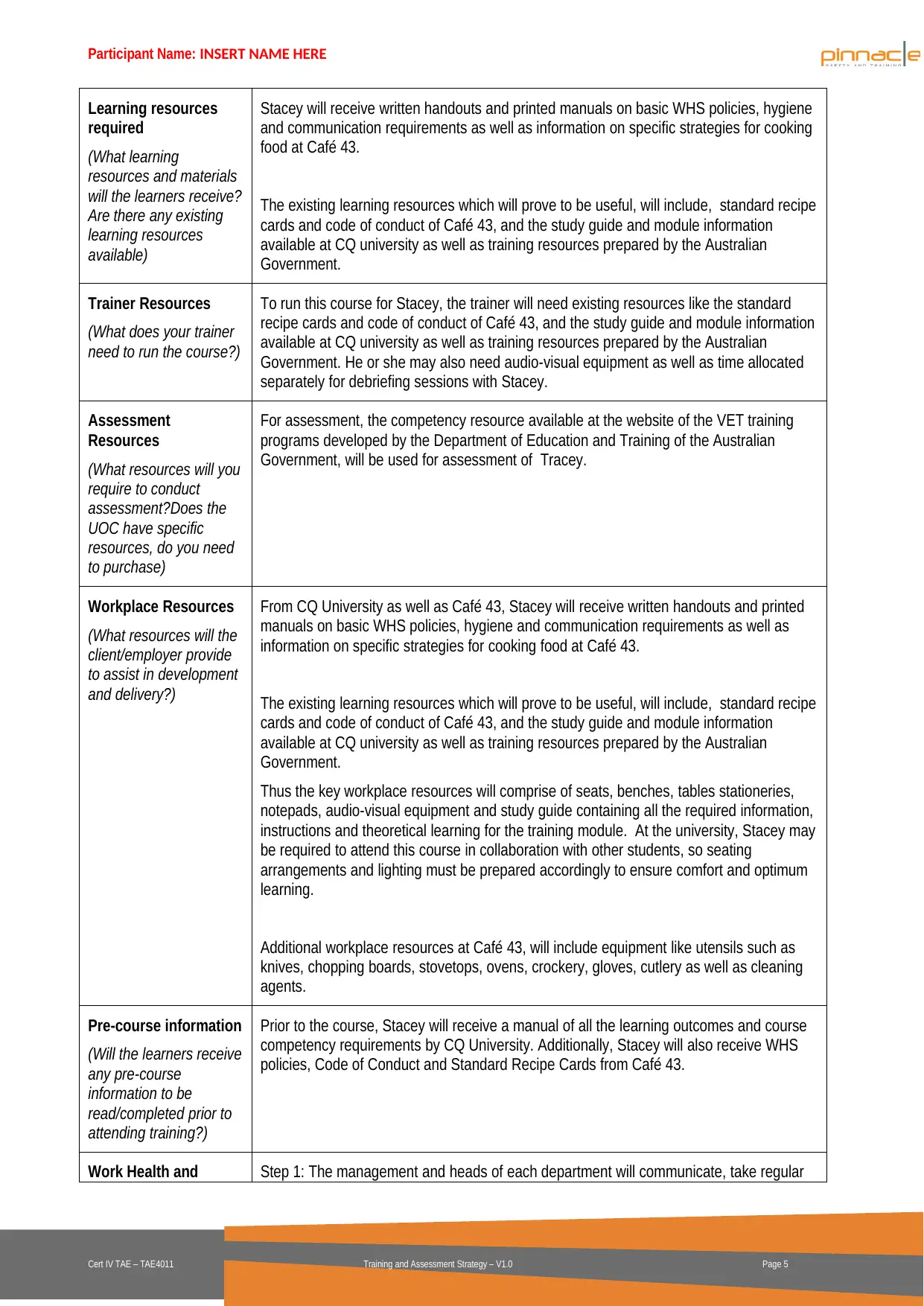
Participant Name: INSERT NAME HERE
Learning resources
required
(What learning
resources and materials
will the learners receive?
Are there any existing
learning resources
available)
Stacey will receive written handouts and printed manuals on basic WHS policies, hygiene
and communication requirements as well as information on specific strategies for cooking
food at Café 43.
The existing learning resources which will prove to be useful, will include, standard recipe
cards and code of conduct of Café 43, and the study guide and module information
available at CQ university as well as training resources prepared by the Australian
Government.
Trainer Resources
(What does your trainer
need to run the course?)
To run this course for Stacey, the trainer will need existing resources like the standard
recipe cards and code of conduct of Café 43, and the study guide and module information
available at CQ university as well as training resources prepared by the Australian
Government. He or she may also need audio-visual equipment as well as time allocated
separately for debriefing sessions with Stacey.
Assessment
Resources
(What resources will you
require to conduct
assessment?Does the
UOC have specific
resources, do you need
to purchase)
For assessment, the competency resource available at the website of the VET training
programs developed by the Department of Education and Training of the Australian
Government, will be used for assessment of Tracey.
Workplace Resources
(What resources will the
client/employer provide
to assist in development
and delivery?)
From CQ University as well as Café 43, Stacey will receive written handouts and printed
manuals on basic WHS policies, hygiene and communication requirements as well as
information on specific strategies for cooking food at Café 43.
The existing learning resources which will prove to be useful, will include, standard recipe
cards and code of conduct of Café 43, and the study guide and module information
available at CQ university as well as training resources prepared by the Australian
Government.
Thus the key workplace resources will comprise of seats, benches, tables stationeries,
notepads, audio-visual equipment and study guide containing all the required information,
instructions and theoretical learning for the training module. At the university, Stacey may
be required to attend this course in collaboration with other students, so seating
arrangements and lighting must be prepared accordingly to ensure comfort and optimum
learning.
Additional workplace resources at Café 43, will include equipment like utensils such as
knives, chopping boards, stovetops, ovens, crockery, gloves, cutlery as well as cleaning
agents.
Pre-course information
(Will the learners receive
any pre-course
information to be
read/completed prior to
attending training?)
Prior to the course, Stacey will receive a manual of all the learning outcomes and course
competency requirements by CQ University. Additionally, Stacey will also receive WHS
policies, Code of Conduct and Standard Recipe Cards from Café 43.
Work Health and Step 1: The management and heads of each department will communicate, take regular
Cert IV TAE – TAE4011 Training and Assessment Strategy – V1.0 Page 5
Learning resources
required
(What learning
resources and materials
will the learners receive?
Are there any existing
learning resources
available)
Stacey will receive written handouts and printed manuals on basic WHS policies, hygiene
and communication requirements as well as information on specific strategies for cooking
food at Café 43.
The existing learning resources which will prove to be useful, will include, standard recipe
cards and code of conduct of Café 43, and the study guide and module information
available at CQ university as well as training resources prepared by the Australian
Government.
Trainer Resources
(What does your trainer
need to run the course?)
To run this course for Stacey, the trainer will need existing resources like the standard
recipe cards and code of conduct of Café 43, and the study guide and module information
available at CQ university as well as training resources prepared by the Australian
Government. He or she may also need audio-visual equipment as well as time allocated
separately for debriefing sessions with Stacey.
Assessment
Resources
(What resources will you
require to conduct
assessment?Does the
UOC have specific
resources, do you need
to purchase)
For assessment, the competency resource available at the website of the VET training
programs developed by the Department of Education and Training of the Australian
Government, will be used for assessment of Tracey.
Workplace Resources
(What resources will the
client/employer provide
to assist in development
and delivery?)
From CQ University as well as Café 43, Stacey will receive written handouts and printed
manuals on basic WHS policies, hygiene and communication requirements as well as
information on specific strategies for cooking food at Café 43.
The existing learning resources which will prove to be useful, will include, standard recipe
cards and code of conduct of Café 43, and the study guide and module information
available at CQ university as well as training resources prepared by the Australian
Government.
Thus the key workplace resources will comprise of seats, benches, tables stationeries,
notepads, audio-visual equipment and study guide containing all the required information,
instructions and theoretical learning for the training module. At the university, Stacey may
be required to attend this course in collaboration with other students, so seating
arrangements and lighting must be prepared accordingly to ensure comfort and optimum
learning.
Additional workplace resources at Café 43, will include equipment like utensils such as
knives, chopping boards, stovetops, ovens, crockery, gloves, cutlery as well as cleaning
agents.
Pre-course information
(Will the learners receive
any pre-course
information to be
read/completed prior to
attending training?)
Prior to the course, Stacey will receive a manual of all the learning outcomes and course
competency requirements by CQ University. Additionally, Stacey will also receive WHS
policies, Code of Conduct and Standard Recipe Cards from Café 43.
Work Health and Step 1: The management and heads of each department will communicate, take regular
Cert IV TAE – TAE4011 Training and Assessment Strategy – V1.0 Page 5
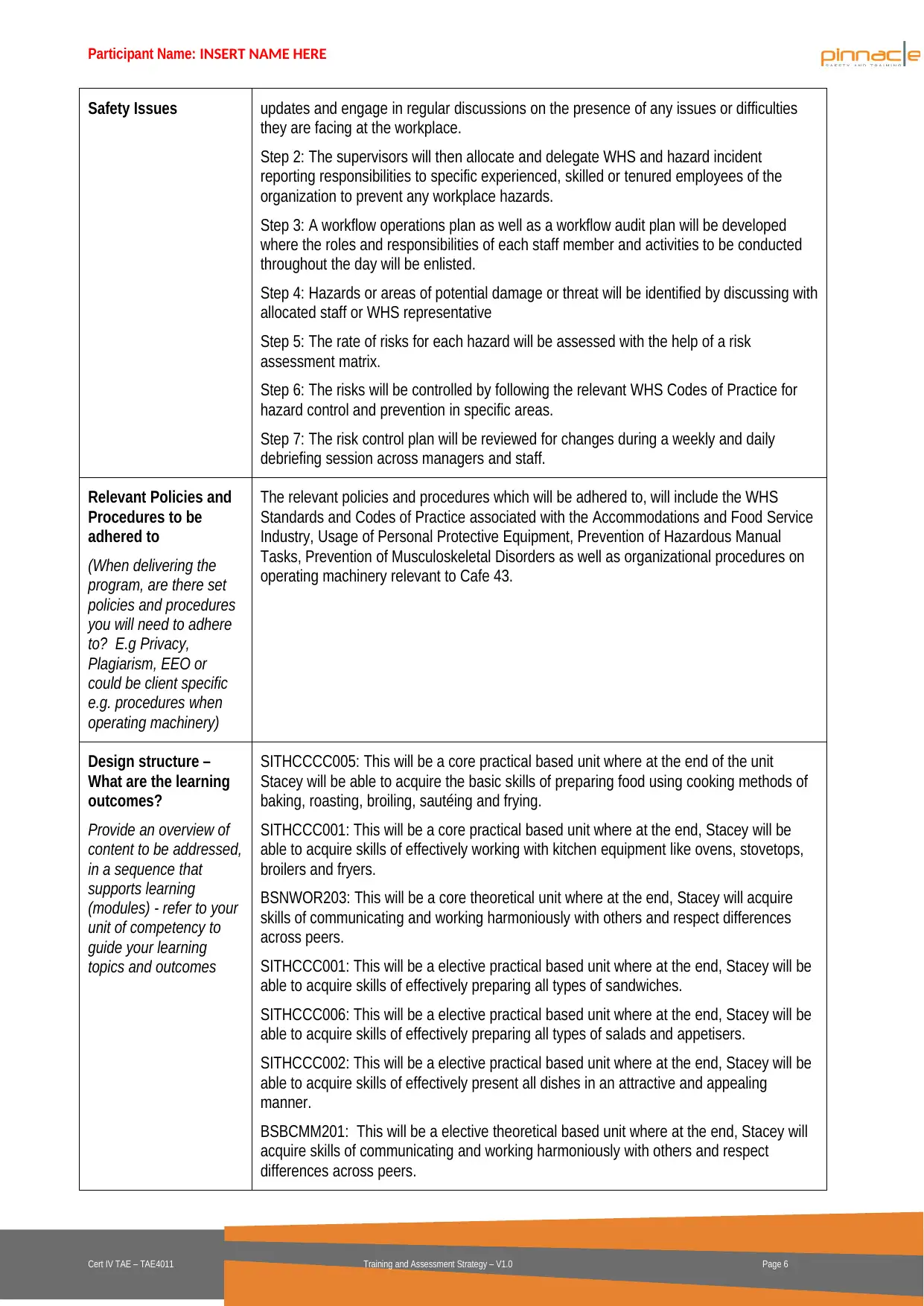
Participant Name: INSERT NAME HERE
Safety Issues updates and engage in regular discussions on the presence of any issues or difficulties
they are facing at the workplace.
Step 2: The supervisors will then allocate and delegate WHS and hazard incident
reporting responsibilities to specific experienced, skilled or tenured employees of the
organization to prevent any workplace hazards.
Step 3: A workflow operations plan as well as a workflow audit plan will be developed
where the roles and responsibilities of each staff member and activities to be conducted
throughout the day will be enlisted.
Step 4: Hazards or areas of potential damage or threat will be identified by discussing with
allocated staff or WHS representative
Step 5: The rate of risks for each hazard will be assessed with the help of a risk
assessment matrix.
Step 6: The risks will be controlled by following the relevant WHS Codes of Practice for
hazard control and prevention in specific areas.
Step 7: The risk control plan will be reviewed for changes during a weekly and daily
debriefing session across managers and staff.
Relevant Policies and
Procedures to be
adhered to
(When delivering the
program, are there set
policies and procedures
you will need to adhere
to? E.g Privacy,
Plagiarism, EEO or
could be client specific
e.g. procedures when
operating machinery)
The relevant policies and procedures which will be adhered to, will include the WHS
Standards and Codes of Practice associated with the Accommodations and Food Service
Industry, Usage of Personal Protective Equipment, Prevention of Hazardous Manual
Tasks, Prevention of Musculoskeletal Disorders as well as organizational procedures on
operating machinery relevant to Cafe 43.
Design structure –
What are the learning
outcomes?
Provide an overview of
content to be addressed,
in a sequence that
supports learning
(modules) - refer to your
unit of competency to
guide your learning
topics and outcomes
SITHCCCC005: This will be a core practical based unit where at the end of the unit
Stacey will be able to acquire the basic skills of preparing food using cooking methods of
baking, roasting, broiling, sautéing and frying.
SITHCCC001: This will be a core practical based unit where at the end, Stacey will be
able to acquire skills of effectively working with kitchen equipment like ovens, stovetops,
broilers and fryers.
BSNWOR203: This will be a core theoretical unit where at the end, Stacey will acquire
skills of communicating and working harmoniously with others and respect differences
across peers.
SITHCCC001: This will be a elective practical based unit where at the end, Stacey will be
able to acquire skills of effectively preparing all types of sandwiches.
SITHCCC006: This will be a elective practical based unit where at the end, Stacey will be
able to acquire skills of effectively preparing all types of salads and appetisers.
SITHCCC002: This will be a elective practical based unit where at the end, Stacey will be
able to acquire skills of effectively present all dishes in an attractive and appealing
manner.
BSBCMM201: This will be a elective theoretical based unit where at the end, Stacey will
acquire skills of communicating and working harmoniously with others and respect
differences across peers.
Cert IV TAE – TAE4011 Training and Assessment Strategy – V1.0 Page 6
Safety Issues updates and engage in regular discussions on the presence of any issues or difficulties
they are facing at the workplace.
Step 2: The supervisors will then allocate and delegate WHS and hazard incident
reporting responsibilities to specific experienced, skilled or tenured employees of the
organization to prevent any workplace hazards.
Step 3: A workflow operations plan as well as a workflow audit plan will be developed
where the roles and responsibilities of each staff member and activities to be conducted
throughout the day will be enlisted.
Step 4: Hazards or areas of potential damage or threat will be identified by discussing with
allocated staff or WHS representative
Step 5: The rate of risks for each hazard will be assessed with the help of a risk
assessment matrix.
Step 6: The risks will be controlled by following the relevant WHS Codes of Practice for
hazard control and prevention in specific areas.
Step 7: The risk control plan will be reviewed for changes during a weekly and daily
debriefing session across managers and staff.
Relevant Policies and
Procedures to be
adhered to
(When delivering the
program, are there set
policies and procedures
you will need to adhere
to? E.g Privacy,
Plagiarism, EEO or
could be client specific
e.g. procedures when
operating machinery)
The relevant policies and procedures which will be adhered to, will include the WHS
Standards and Codes of Practice associated with the Accommodations and Food Service
Industry, Usage of Personal Protective Equipment, Prevention of Hazardous Manual
Tasks, Prevention of Musculoskeletal Disorders as well as organizational procedures on
operating machinery relevant to Cafe 43.
Design structure –
What are the learning
outcomes?
Provide an overview of
content to be addressed,
in a sequence that
supports learning
(modules) - refer to your
unit of competency to
guide your learning
topics and outcomes
SITHCCCC005: This will be a core practical based unit where at the end of the unit
Stacey will be able to acquire the basic skills of preparing food using cooking methods of
baking, roasting, broiling, sautéing and frying.
SITHCCC001: This will be a core practical based unit where at the end, Stacey will be
able to acquire skills of effectively working with kitchen equipment like ovens, stovetops,
broilers and fryers.
BSNWOR203: This will be a core theoretical unit where at the end, Stacey will acquire
skills of communicating and working harmoniously with others and respect differences
across peers.
SITHCCC001: This will be a elective practical based unit where at the end, Stacey will be
able to acquire skills of effectively preparing all types of sandwiches.
SITHCCC006: This will be a elective practical based unit where at the end, Stacey will be
able to acquire skills of effectively preparing all types of salads and appetisers.
SITHCCC002: This will be a elective practical based unit where at the end, Stacey will be
able to acquire skills of effectively present all dishes in an attractive and appealing
manner.
BSBCMM201: This will be a elective theoretical based unit where at the end, Stacey will
acquire skills of communicating and working harmoniously with others and respect
differences across peers.
Cert IV TAE – TAE4011 Training and Assessment Strategy – V1.0 Page 6
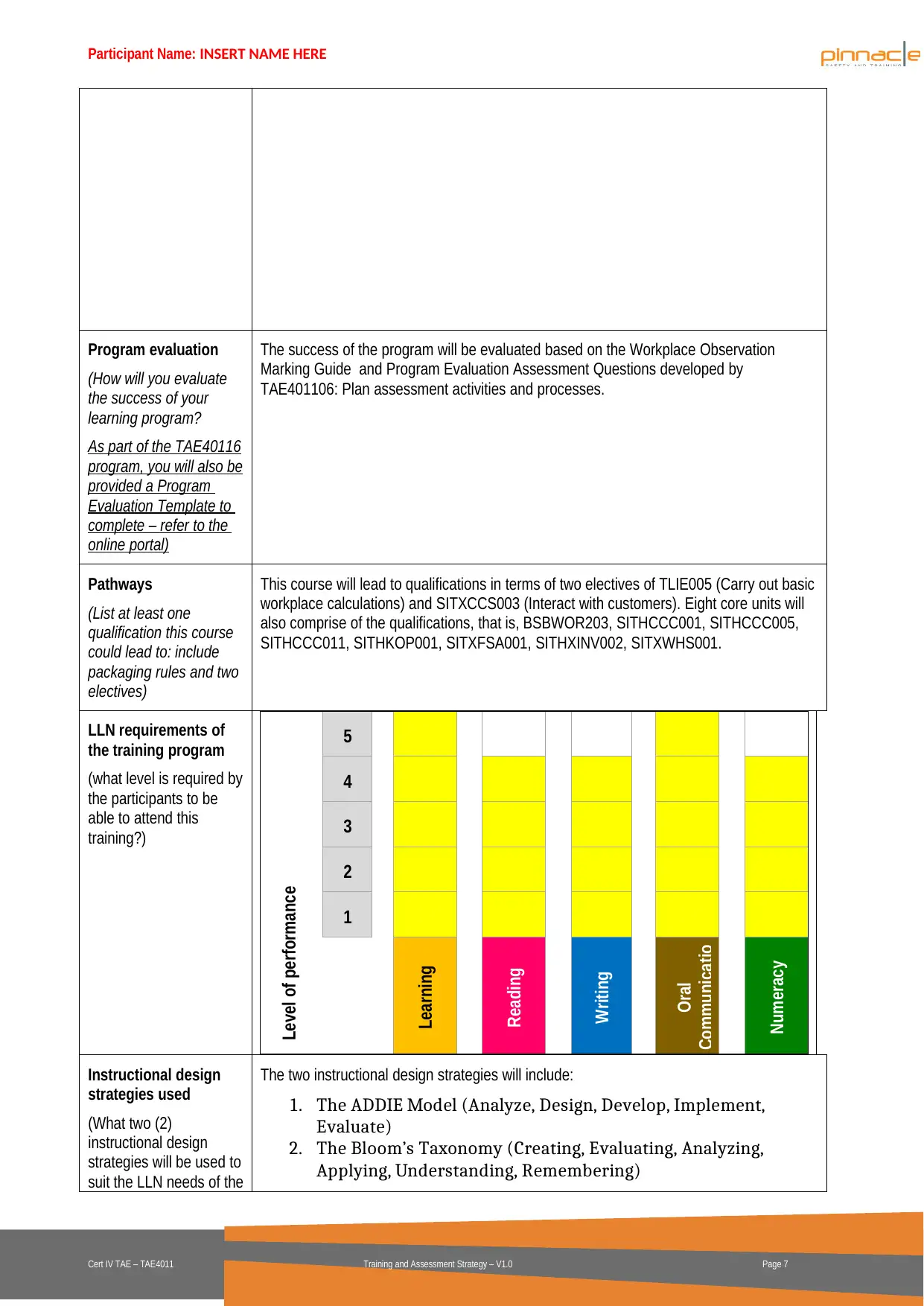
Participant Name: INSERT NAME HERE
Program evaluation
(How will you evaluate
the success of your
learning program?
As part of the TAE40116
program, you will also be
provided a Program
Evaluation Template to
complete – refer to the
online portal)
The success of the program will be evaluated based on the Workplace Observation
Marking Guide and Program Evaluation Assessment Questions developed by
TAE401106: Plan assessment activities and processes.
Pathways
(List at least one
qualification this course
could lead to: include
packaging rules and two
electives)
This course will lead to qualifications in terms of two electives of TLIE005 (Carry out basic
workplace calculations) and SITXCCS003 (Interact with customers). Eight core units will
also comprise of the qualifications, that is, BSBWOR203, SITHCCC001, SITHCCC005,
SITHCCC011, SITHKOP001, SITXFSA001, SITHXINV002, SITXWHS001.
LLN requirements of
the training program
(what level is required by
the participants to be
able to attend this
training?)
Level of performance
5
4
3
2
1
Learning
Reading
Writing
Oral
Communicatio
Numeracy
Instructional design
strategies used
(What two (2)
instructional design
strategies will be used to
suit the LLN needs of the
The two instructional design strategies will include:
1. The ADDIE Model (Analyze, Design, Develop, Implement,
Evaluate)
2. The Bloom’s Taxonomy (Creating, Evaluating, Analyzing,
Applying, Understanding, Remembering)
Cert IV TAE – TAE4011 Training and Assessment Strategy – V1.0 Page 7
Program evaluation
(How will you evaluate
the success of your
learning program?
As part of the TAE40116
program, you will also be
provided a Program
Evaluation Template to
complete – refer to the
online portal)
The success of the program will be evaluated based on the Workplace Observation
Marking Guide and Program Evaluation Assessment Questions developed by
TAE401106: Plan assessment activities and processes.
Pathways
(List at least one
qualification this course
could lead to: include
packaging rules and two
electives)
This course will lead to qualifications in terms of two electives of TLIE005 (Carry out basic
workplace calculations) and SITXCCS003 (Interact with customers). Eight core units will
also comprise of the qualifications, that is, BSBWOR203, SITHCCC001, SITHCCC005,
SITHCCC011, SITHKOP001, SITXFSA001, SITHXINV002, SITXWHS001.
LLN requirements of
the training program
(what level is required by
the participants to be
able to attend this
training?)
Level of performance
5
4
3
2
1
Learning
Reading
Writing
Oral
Communicatio
Numeracy
Instructional design
strategies used
(What two (2)
instructional design
strategies will be used to
suit the LLN needs of the
The two instructional design strategies will include:
1. The ADDIE Model (Analyze, Design, Develop, Implement,
Evaluate)
2. The Bloom’s Taxonomy (Creating, Evaluating, Analyzing,
Applying, Understanding, Remembering)
Cert IV TAE – TAE4011 Training and Assessment Strategy – V1.0 Page 7
Paraphrase This Document
Need a fresh take? Get an instant paraphrase of this document with our AI Paraphraser
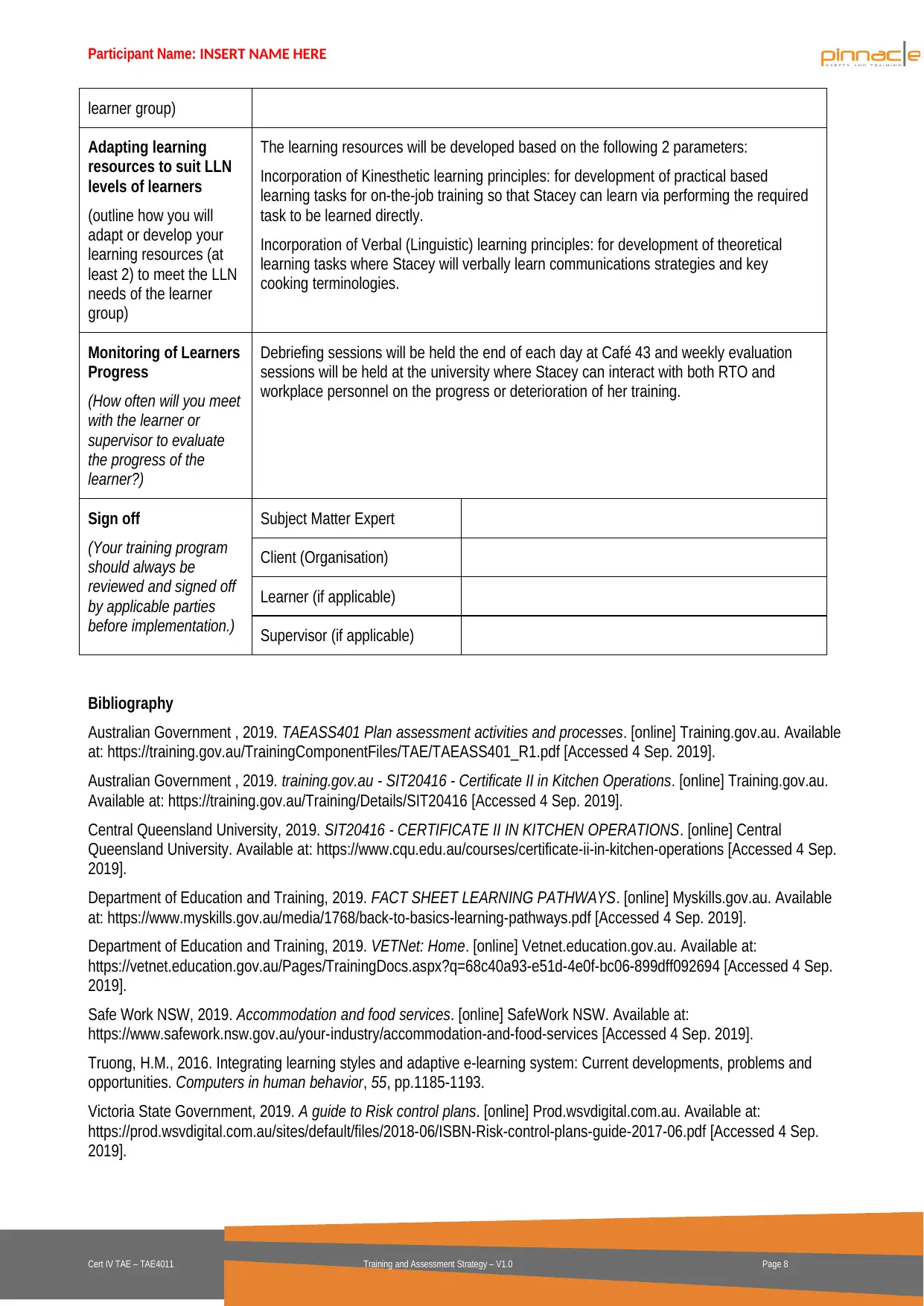
Participant Name: INSERT NAME HERE
learner group)
Adapting learning
resources to suit LLN
levels of learners
(outline how you will
adapt or develop your
learning resources (at
least 2) to meet the LLN
needs of the learner
group)
The learning resources will be developed based on the following 2 parameters:
Incorporation of Kinesthetic learning principles: for development of practical based
learning tasks for on-the-job training so that Stacey can learn via performing the required
task to be learned directly.
Incorporation of Verbal (Linguistic) learning principles: for development of theoretical
learning tasks where Stacey will verbally learn communications strategies and key
cooking terminologies.
Monitoring of Learners
Progress
(How often will you meet
with the learner or
supervisor to evaluate
the progress of the
learner?)
Debriefing sessions will be held the end of each day at Café 43 and weekly evaluation
sessions will be held at the university where Stacey can interact with both RTO and
workplace personnel on the progress or deterioration of her training.
Sign off
(Your training program
should always be
reviewed and signed off
by applicable parties
before implementation.)
Subject Matter Expert
Client (Organisation)
Learner (if applicable)
Supervisor (if applicable)
Bibliography
Australian Government , 2019. TAEASS401 Plan assessment activities and processes. [online] Training.gov.au. Available
at: https://training.gov.au/TrainingComponentFiles/TAE/TAEASS401_R1.pdf [Accessed 4 Sep. 2019].
Australian Government , 2019. training.gov.au - SIT20416 - Certificate II in Kitchen Operations. [online] Training.gov.au.
Available at: https://training.gov.au/Training/Details/SIT20416 [Accessed 4 Sep. 2019].
Central Queensland University, 2019. SIT20416 - CERTIFICATE II IN KITCHEN OPERATIONS. [online] Central
Queensland University. Available at: https://www.cqu.edu.au/courses/certificate-ii-in-kitchen-operations [Accessed 4 Sep.
2019].
Department of Education and Training, 2019. FACT SHEET LEARNING PATHWAYS. [online] Myskills.gov.au. Available
at: https://www.myskills.gov.au/media/1768/back-to-basics-learning-pathways.pdf [Accessed 4 Sep. 2019].
Department of Education and Training, 2019. VETNet: Home. [online] Vetnet.education.gov.au. Available at:
https://vetnet.education.gov.au/Pages/TrainingDocs.aspx?q=68c40a93-e51d-4e0f-bc06-899dff092694 [Accessed 4 Sep.
2019].
Safe Work NSW, 2019. Accommodation and food services. [online] SafeWork NSW. Available at:
https://www.safework.nsw.gov.au/your-industry/accommodation-and-food-services [Accessed 4 Sep. 2019].
Truong, H.M., 2016. Integrating learning styles and adaptive e-learning system: Current developments, problems and
opportunities. Computers in human behavior, 55, pp.1185-1193.
Victoria State Government, 2019. A guide to Risk control plans. [online] Prod.wsvdigital.com.au. Available at:
https://prod.wsvdigital.com.au/sites/default/files/2018-06/ISBN-Risk-control-plans-guide-2017-06.pdf [Accessed 4 Sep.
2019].
Cert IV TAE – TAE4011 Training and Assessment Strategy – V1.0 Page 8
learner group)
Adapting learning
resources to suit LLN
levels of learners
(outline how you will
adapt or develop your
learning resources (at
least 2) to meet the LLN
needs of the learner
group)
The learning resources will be developed based on the following 2 parameters:
Incorporation of Kinesthetic learning principles: for development of practical based
learning tasks for on-the-job training so that Stacey can learn via performing the required
task to be learned directly.
Incorporation of Verbal (Linguistic) learning principles: for development of theoretical
learning tasks where Stacey will verbally learn communications strategies and key
cooking terminologies.
Monitoring of Learners
Progress
(How often will you meet
with the learner or
supervisor to evaluate
the progress of the
learner?)
Debriefing sessions will be held the end of each day at Café 43 and weekly evaluation
sessions will be held at the university where Stacey can interact with both RTO and
workplace personnel on the progress or deterioration of her training.
Sign off
(Your training program
should always be
reviewed and signed off
by applicable parties
before implementation.)
Subject Matter Expert
Client (Organisation)
Learner (if applicable)
Supervisor (if applicable)
Bibliography
Australian Government , 2019. TAEASS401 Plan assessment activities and processes. [online] Training.gov.au. Available
at: https://training.gov.au/TrainingComponentFiles/TAE/TAEASS401_R1.pdf [Accessed 4 Sep. 2019].
Australian Government , 2019. training.gov.au - SIT20416 - Certificate II in Kitchen Operations. [online] Training.gov.au.
Available at: https://training.gov.au/Training/Details/SIT20416 [Accessed 4 Sep. 2019].
Central Queensland University, 2019. SIT20416 - CERTIFICATE II IN KITCHEN OPERATIONS. [online] Central
Queensland University. Available at: https://www.cqu.edu.au/courses/certificate-ii-in-kitchen-operations [Accessed 4 Sep.
2019].
Department of Education and Training, 2019. FACT SHEET LEARNING PATHWAYS. [online] Myskills.gov.au. Available
at: https://www.myskills.gov.au/media/1768/back-to-basics-learning-pathways.pdf [Accessed 4 Sep. 2019].
Department of Education and Training, 2019. VETNet: Home. [online] Vetnet.education.gov.au. Available at:
https://vetnet.education.gov.au/Pages/TrainingDocs.aspx?q=68c40a93-e51d-4e0f-bc06-899dff092694 [Accessed 4 Sep.
2019].
Safe Work NSW, 2019. Accommodation and food services. [online] SafeWork NSW. Available at:
https://www.safework.nsw.gov.au/your-industry/accommodation-and-food-services [Accessed 4 Sep. 2019].
Truong, H.M., 2016. Integrating learning styles and adaptive e-learning system: Current developments, problems and
opportunities. Computers in human behavior, 55, pp.1185-1193.
Victoria State Government, 2019. A guide to Risk control plans. [online] Prod.wsvdigital.com.au. Available at:
https://prod.wsvdigital.com.au/sites/default/files/2018-06/ISBN-Risk-control-plans-guide-2017-06.pdf [Accessed 4 Sep.
2019].
Cert IV TAE – TAE4011 Training and Assessment Strategy – V1.0 Page 8
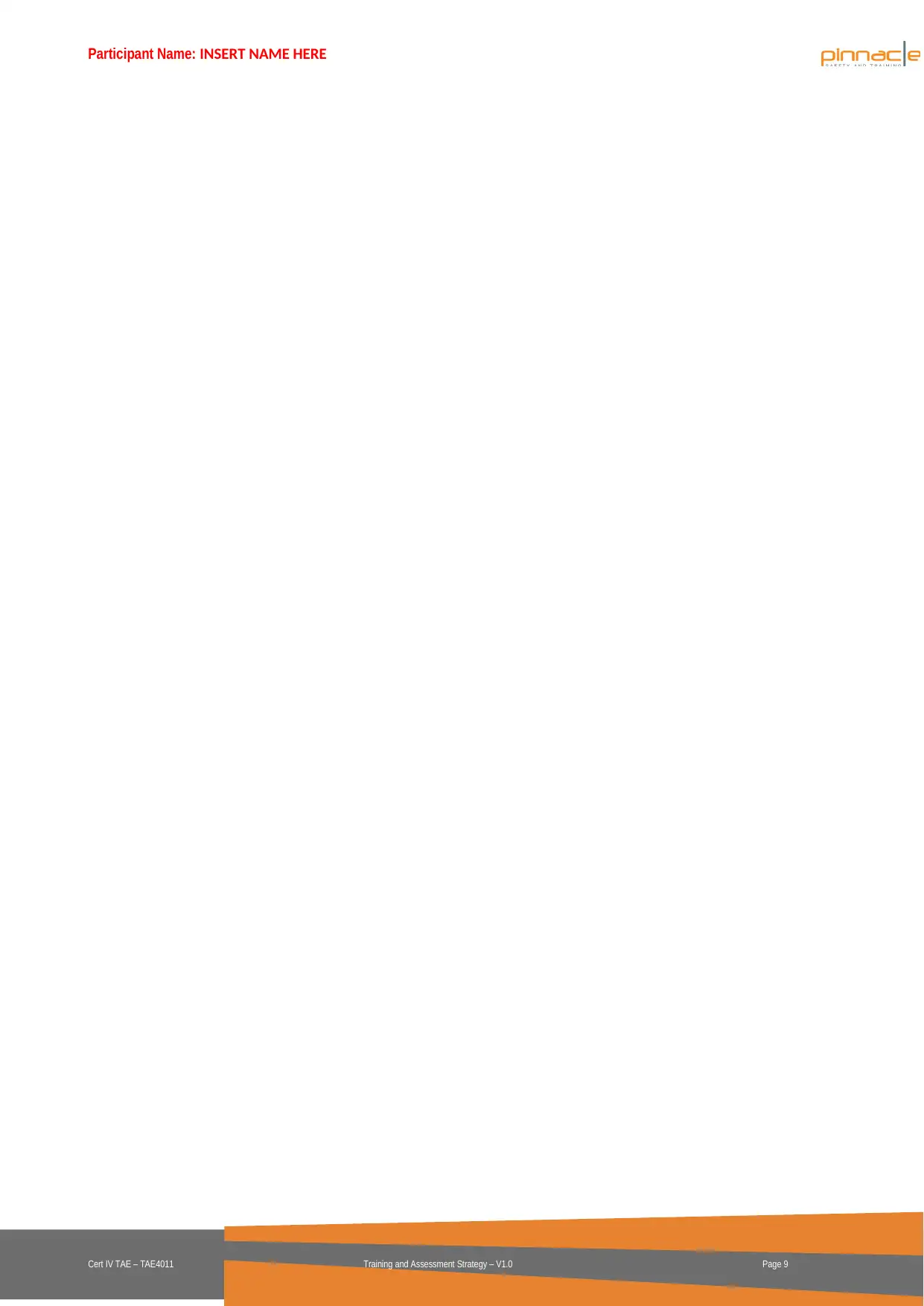
Participant Name: INSERT NAME HERE
Cert IV TAE – TAE4011 Training and Assessment Strategy – V1.0 Page 9
Cert IV TAE – TAE4011 Training and Assessment Strategy – V1.0 Page 9
1 out of 9
Your All-in-One AI-Powered Toolkit for Academic Success.
+13062052269
info@desklib.com
Available 24*7 on WhatsApp / Email
![[object Object]](/_next/static/media/star-bottom.7253800d.svg)
Unlock your academic potential
© 2024 | Zucol Services PVT LTD | All rights reserved.

